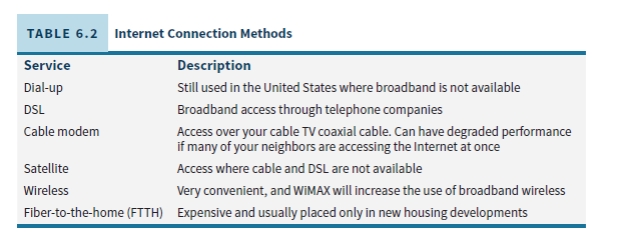Asked by Lorena Edanol on Jul 04, 2024

Verified
List and describe the six ways you can access the Internet. When you have to start purchasing your own Internet connection, which one will you choose and why? HINT: You should consider availability and the advantages/disadvantages of each option assuming availability; you should research beyond what is found in the book.
Internet Connection
The means by which individuals or organizations access the Internet, using technologies like DSL, cable modem, Fiber, or wireless.
Availability
The degree to which a system, component, or data is accessible and usable upon demand by an authorized entity.
- Detail different methods of accessing the Internet and evaluate them based on various criteria.

Verified Answer
ZK
Zybrea KnightJul 09, 2024
Final Answer :
Dial-up = least desirable, won't be watching YouTube videos using it; can't use the phone when on the Internet DSL = don't have to share with others on the network so it is more secure and don't have slow down problems in the evenings; problems = harder to set-up Cable modem = inexpensive and easy to set-up but speeds vary and will slow down when many people are using it Satellite = like dial-up (not desirable), much slower than other options and have a download limit (one example website:"http://www.reviews.org/internet-service/best-satellite-internet-providers/" http: //www.reviews.org/Internet-service/best-satellite-Internet-providers/) Wireless = this generally applies to use on smartphones (all students will probably mention this), but this isn't typically considered a viable solution for main use in the home (currently under experimentation by Google according to IT's About Business 6.2 and "https://www.wired.com/2017/02/google-fiber-restructure/" https: //www.wired.com/2017/02/google-fiber-restructure/) FTTH = extremely fast service offered by many companies now (not just new housing developments as mentioned in the text) and not necessarily that expensive but it is limited by location 


Learning Objectives
- Detail different methods of accessing the Internet and evaluate them based on various criteria.
Related questions
Cable and DSL Modems Offer Broadband Access
Burying Fiber-Optic Cables Costs Approximately $30,000 Per Mile, So Telecommunications ...
Most People in the United States Have Faster Download Speeds ...
With VoIP, Your Digital Voice Signals Are Converted to Analog ...
The ________ IP Addressing Scheme Uses 128-Bit Addressing